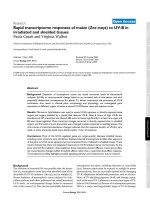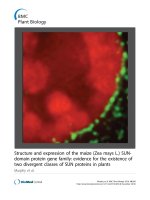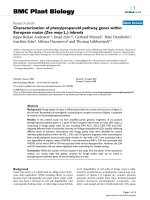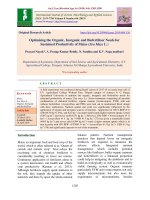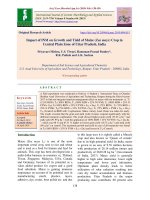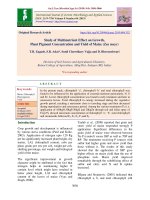Effect of pre and post emergence herbicides on weeds, productivity and profitability of maize (Zea mays L.)
Bạn đang xem bản rút gọn của tài liệu. Xem và tải ngay bản đầy đủ của tài liệu tại đây (294.72 KB, 9 trang )
Int.J.Curr.Microbiol.App.Sci (2020) 9(5): 2797-2805
International Journal of Current Microbiology and Applied Sciences
ISSN: 2319-7706 Volume 9 Number 5 (2020)
Journal homepage:
Original Research Article
/>
Effect of Pre and Post Emergence Herbicides on Weeds,
Productivity and Profitability of Maize (Zea mays L.)
Joyti Jaybhaye, S. U. Kakade*, J. P. Deshmukh, S. S. Thakare and M. S. Solanke
All India Coordinated Research Project on Weed Management, Department of Agronomy,
Dr.Panjabrao Deshmukh Krishi Vidyapeeth, Akola – 444104(M.S), India
*Corresponding author
ABSTRACT
Keywords
Atrazine, Maize,
Pre-emergence,
Post-emergence,
Tembotrione WCE
Article Info
Accepted:
23 April 2020
Available Online:
10 May 2020
A field investigation entitled “Effect of sequential application of pre-emergence and post
emergence herbicides on weeds, productivity and profitability of maize (Zea mays L.)”
was carried out at AICRP on weed management field of Agronomy Department, Dr.
Panjabrao Deshmukh Krishi Vidyapeeth, Akola during the Kharif season of the year 201819 with an objective to study the relative efficacy of pre and post emergence herbicides on
weed control in maize and to study its effect on productivity and profitability of maize.
The experiment was laid out in randomized block design with twelve treatment replicated
thrice. The soil of experimental field characterized as clay loam in texture, having slightly
alkaline pH (7.5), moderate organic carbon status (5.38%), low nitrogen content (219.33
kg ha-1), medium available phosphorus content (15.30 kg ha -1) and high available
potassium (340.67 kg ha-1). Maize (Pioneer hybrid 3396) was sown on 25 th June 2018 at
60×20 cm spacing with 120:60:30 NPK kg ha-1. The results revealed that among the
herbicidal treatments, Atrazine 0.50 kg/ha fb tembotrione 0.120 kg/ha was found to be
effective in controlling weeds across the crop growth period., Among the various
treatments under study weed free recorded significantly higher values of major parameters
whereas, in herbicidal treatments, the maximum growth and yield attributes were recorded
with treatment Atrazine 0.50 kg/ha fb tembotrione 0.120 kg/ha which was at par with
Atrazine 0.50 kg/ha fb 2,4-D sodium salt @0.5 kg/ha. Among the post emergence
herbicides, reduction in weed population, weed dry matter, higher weed control efficiency
(79.78) and lowest weed index (7.62) was found with Atrazine 0.50 kg/ha PE fb
tembotrione 0.120 kg/ha POE 20 DAS. Atrazine 0.50 kg/ha fb tembotrione 0.120 kg/ha
was found most economical with maximum value of GMR (75709 Rs ha -1) , NMR ( 53059
Rs ha-1 ) and B: C ratio (3.34).
Introduction
Maize (Zea mays L.) being one of the most
important cereals and has attained a
commercial crop status and has scope to
increase the present maize yields. Now in
some literature, maize is regarded as “King of
cereals” because of its high production
potential and wider adaptability. In India,
maize occupies a proud place both as food
2797
Int.J.Curr.Microbiol.App.Sci (2020) 9(5): 2797-2805
and feed for animals and it is the third
important food crops after rice and wheat. It is
cultivated over an area of 8.9 million hectares
with a production of about 23 million tones
and productivity of 2584 kg/ha in India,
However in Maharashtra it occupies an area
of about 0.9 million hectare with a production
of 2.06 million tones and productivity of 2900
kg/ha (Anonymous, 2016). Rainy season
maize suffers from severe weed competition
and depending upon the intensity, nature,
stages and duration of weed infestation; yield
losses vary from 28-100 per cent (Patel et al.,
2006). A wide spaced crop suffers from heavy
weed infestation due to slow initial growth
particularly during Kharif season. Weed
depletes 30-40 per cent of applied nutrients
from the soil. They interfere with efficiency
of fertilizer utilization by crops plants because
a sizeable portion of the fertilizer added to the
soil is used by weed. Weeds are regarded as
pest of crops because they lower down the
productivity, increase the cost of production
and inferior the quality of produce. The
quantities of growth factors used by weeds are
thus unavailable to the crop. Many grassy and
broadleaf weeds infest the maize field and
thus, increase the cost of production, as hand
weeding is not effective against these weeds.
Management of weeds is considered to be an
important factor for achieving higher
productivity. Yield loss occurs up to 33% to
complete crop failure due to weed
competition in maize. Rout et al., (1996)
revealed that weeds cause enormous damage
upto 30 to 50 per cent in maize crop. Weeds
also pose severe problems for crop husbandry
and infest fallow land, reduce soil fertility and
moisture conditions and develop a potential
threat to the succeeding crops (Khan et al.,
2003). Due to increased cost and non
availability of labour in required quantity
timely for hand weeding, role of herbicide is
significant preposition. Herbicides not only
control the weeds timely and effectively but
also offer great scope for minimizing the cost
of weed control irrespective of the situation.
The conventional method of weed control
(hoeing/ hand weeding) are very laborious,
expensive and time consuming and needs to
be often repeated at different intervals.
Frequent rainfall during rainfed cropping
season does not permit manual and
mechanical methods of weeding at the
appropriate time. Use of pre and post
emergence application of herbicides would
make herbicidal weed control more
acceptable to farmers which will not change
the existing agronomic practices but will
allow for complete control of weeds.
Sequential use of pre and post emergence
herbicides at temporal variation may help in
avoiding the problem of weeds throughout the
growth stages. Chemical weed management
by using pre emergence and post emergence
herbicides can lead to the efficient and cost
effective control of weeds during critical
period of crop weed competition, which may
not be possible in manual or mechanical
weeding due to its high cost of cultivation(
Triveni et al.2017). The present investigation
was therefore planned with a objective to
study the efficacy of sequential application of
pre and post emergence herbicides and its
effect on weed flora, growth, productivity and
profitability of maize (Zea mays L.).
Materials and Methods
The present field experiment was conducted
during Kharif season of the year 2018-19 at
the research farm of AICRP-Weed
Management, Dr. Panjabrao Deshmukh
Krishi Vidyapeeth, Akola (M.S.) in
Randomized Block Design with three
replication having twelve different treatments
of weed management including Atrazine@1
kg a.i/ha.(T1), Pendimethalin@1kg/ha (T2),
Metribuzin
0.35
kg/ha(T3),
Atrazine
0.50kg/ha + Pendimethalin 0.50kg/ha(T4),
2,4-D sodium salt@ 0.80 kg/ha (T5),
2798
Int.J.Curr.Microbiol.App.Sci (2020) 9(5): 2797-2805
Tembotrione 0.120 kg/ha (T6), Atrazine 0.50
kg/ha fb 2,4-D sodium salt @0.5kg/ha (T7),
Atrazine 0.50 kg/ha fb tembotrione 0.120
kg/ha (T8), Topramezone 0.0252kg/ha (T9),
Halosulfuron methyl 0.05 kg/ha (T10), Weed
free(T11)and Weedy check (T12). The soil of
experimental field characterized as clay loam
in texture, having slightly alkaline pH (7.5),
moderate organic carbon status (5.38%), low
nitrogen content (219.33 kg ha-1), medium
available phosphorus content (15.30 kg ha-1)
and high available potassium (340.67 kg ha-1).
Maize (Pioneer hybrid 3396) was sown on
25th June 2018 at 60 × 20 cm spacing with
120:60:30 NPK kg ha-1. The crop was
harvested on 12th October, 2018. The
application of herbicide was done as per
the treatments with manually operated
knapsack sprayer attached with a flood jet
nozzle. After calibrating the sprayer, water
volume used was 700 lit. per ha. for PE and
500 lit. per ha. for PoE. The observations on
weed density and weed biomass were taken at
20 days interval upto harvest from four
randomly selected spots by using a quadrate
of 50 cm x 50 cm quadrate from net plot area.
Then weeds were grouped as monocot species
and dicot species. Weed control efficiency
(WCE) was calculated by using standard
formula suggested by Maity and Mukherjee
(2011). Phytotoxicity symptoms due to
herbicides on crop was recorded by using a
visual score scale of 0-10. Visual assessment
of herbicide toxicity on crop was monitored
10 days after application of herbicide in
respective treatment. Data on various growth
and yield attributing characters were
statistically analysed as per the standard
procedure.
Results and Discussion
Weed flora
Both broad and narrow leaved weeds were
observed but dominance of broad leaved
weeds was observed in entire field. The major
weed flora during kharif season in maize crop
in the selected area composed of Xanthium
strumarium, Celosia argentea, Tridax
procumbens, Phyllanthus niruri, Portulaca
oleracae,
Lagasca
mollis,
Euphorbia
geniculata euphorbia hirta, phyllanthus
niruri, Abutilon indicum, Abelmoschus
moschatus, Boerhavia diffusa, Calotropis
gigantea, Ageratum conyzoides, Bidenspilosa,
Mimosa pudica, Alternanathera triandra
parthenium Hysterophorus, Digera arvensis
among the dicot weeds and Cynodon
dactylon, Cyperus rotundus, Amaranthis
viridis, Dinebra arabica, Panicum spp.
Cynodon dactylon, Cyperu srotundus,
commelina benghalensis, Ischaemum pilosum,
Digitaria sanguinalis, Dinebra retroflexa,
Poa annua, were the major monocot weeds
observed in the experimental field.
Effect on weeds
The data presented in Tables 1 revealed that
the weed control treatments significantly
reduced the total (monocot+ dicot) weed
population and total dry weed biomass when
compared with unweeded control. Initially at
20 DAS significantly lowest total weeds
density was recorded in weed free treatment
(T11) than rest of the weed management
treatments. Among the herbicidal treatments
Atrazine@1 kg a.i/ha (T1) and Metribuzin
0.35 kg/ha (T3), produced lower weed count
but were statistically at par with each other.
The Weedy check (T12) recorded significantly
higher weed population at all the growth
stages during the experimentation. At harvest
stage, treatment weed free (T11) found
significantly superior in reducing the total
weeds population than rest of the weed
management treatments. The combination of
Atrazine 0.50kg/ha fb tembotrione 0.120
kg/ha (T8) showed its superiority in lowering
down the weed population over all other
herbicidal treatments. Total weed density and
2799
Int.J.Curr.Microbiol.App.Sci (2020) 9(5): 2797-2805
weed dry biomass was reduced significantly
due to various weed control treatments at all
stages of crop growth. This might be due to
the herbicidal application alone and in
combination which were effective in timely
reducing total weed population. Similar
results were reported by Gantoli et al., (2013),
Madhavi et al., (2014) and Singh et al.,
(2015).
weeds, which provided favorable conditions
for crop growth which ultimately increased
the grain yield of maize crop as compared to
weedy check treatment. This result
corroborate with finding of Patel et al.,
(2006), Shantveerayya and Agasimani (2012)
and Gantoli et al., (2013).
Weed control efficiency of maize was
significantly influenced by weed management
treatments, where all the treatments resulted
in increase of weed control efficiency over the
weedy check. The sequential application of
pre and post emergence herbicides was found
superior to only post emergence herbicide
applications. The highest weed control
efficiency was observed in treatment Weed
free (T11) from 20 DAS up to at harvest,
because of keeping weed free environment
and found superior over rest of all herbicidal
treatments. Among the herbicides at harvest
,the highest weed control efficiency (79.78%)
was found with atrazine 0.50 kg /ha fb
tembotrione 0.120 kg/ha POE 20 DAS (T8)
followed by Atrazine 0.50 kg /ha PE fb 2,4-D
sodium salt @ 0.50 kg/ha POE 30 DAS
(77.95%) and Atrazine 1.0 kg/ha PE (70.06) .
This showed that all the pre -emergence and
post emergence herbicides used in this
experiment were compatible, which increased
their efficiency without any phytotoxic effect
causing adverse effect on maize crop. Data on
weed index as indicated in Table 1 showed
the least yield reduction (7.62%) with atrazine
0.50 kg /ha fb tembotrione 0.120 kg/ha POE
20 DAS followed by the treatments Atrazine
0.50 kg/ha fb 2,4-D sodium salt @ 0.5kg/ha
(9.16%) and Atrazine @1 kg a.i/ha (11.6%).
Whereas yield reduction varied from 7.62% to
31.26 % in the herbicide applied plots as
compared to weed free treatment. The weed
index was lower in all the treatments as
compared to weedy check. Lower is the weed
index in chemical treatments, better the
efficiency of that herbicide in controlling
Weed management treatments significantly
affected the growth and yield attributing
characters of maize(Table-3). Significantly
maximum plant height (226.29 cm) and plant
dry matter (234.80 g) of maize at harvest was
recorded in weed free treatment which was at
par with atrazine 0.50 kg /ha fb tembotrione
0.120 kg/ha POE 20 DAS and Atrazine 0.50
kg /ha fb 2,4-D sodium salt @ 0.50 kg/ha
POE 30 DAS . Significant reduction in plant
height was noticed in unweeded control
treatment at harvest might be due to the fact
that weeds suppressed the vegetative growth
of plants by the competition between crop and
weeds for soil moisture, plant nutrients, solar
radiation and space during active growth
period. Taller plants with broader leaf area
might have accumulated higher plant dry
matter at harvest satge of maize. Similar
results were found by Walia et al., (2007) and
Kandasamy (2018).
Effect on growth and yield
Significantly maximum cob weight (225.83)
at harvest was found in weed free treatment
and among the herbicidal treatments
maximum cob weight was recorded in
atrazine 0.50 kg /ha fb tembotrione 0.120
kg/ha POE 20 DAS (219.23 g). Similar trend
was observed with regards to grain weight per
cob which was found maximum (147.83 g) in
weed free treatment followed by 0.50 kg /ha
fb tembotrione 0.120 kg/ha POE 20 DAS
(144.10). Significantly higher test weight was
found in weed free treatment over rest of the
treatments. The lowest yield attributes values
were recorded with weedy check (Table 3).
2800
Int.J.Curr.Microbiol.App.Sci (2020) 9(5): 2797-2805
Table.1 Weed density (No./m2) and weed dry matter (g/m2) as influenced by different weed control treatments in maize
Treatments
T1 : Atrazine 1 kg a.i/ha PE
T2 : Pendimethalin 1 kg/ha PE
T3 : Metribuzin 0.35 kg/ha PE
T4 : Atrazine 0.50 kg + Pendimethalin
0.50kg/ha PE
T5 : 2,4-D sodium salt @ 0.80 kg/ha POE 30
DAS
T6 : Tembotrione 0.120 kg/ha POE 20 DAS
T7 : Atrazine 0.50 kg /ha fb 2,4-D sodium salt
@ 0.50 kg/ha POE 30 DAS
T8 : Atrazine 0.50 kg/ha fb tembotrione 0.120
kg/ha POE 20 DAS
T9 : Topramezone 0.0252 kg/ha POE 20 DAS
T10 : Halosulfuron methyl 0.05 kg/ha POE 20
DAS
T11 : Weed free
T12 : Weedy check
SE (M) ±
C. D. at 5 %
Total weed density (No./m2)
20
20
40
60
80
DAS
DAS
DAS
DAS
DAS
At
harvest
Weed dry matter (g/m2)
40
60
80
DAS
DAS
DAS
At
harvest
3.99
(15.43)
5.44
(27.46)
3.71
5.80
7.37
7.53
(13.27) (33.28) (55.47) (56.20)
5.07
7.52
7.47
8.34
(25.32) (56.06) (71.20) (72.47)
6.94
(47.70)
8.09
(64.87)
5.70
(29.65)
7.95
(63.03)
6.91
(44.20)
8.70
(75.13)
7.07
(43.9)
8.79
(76.67)
6.57
(42.00)
8.39
(69.93)
4.27
(17.80)
5.02
(24.67)
4.49
6.51
7.73
7.89
(19.77) (41.92) (58.43) (61.83)
4.75
6.85
8.02
7.82
(22.13) (46.47) (63.83) (66.09)
8.44
(60.06)
7.29
(52.77)
5.64
(47.00)
7.00
(35.17)
7.66
(60.78)
7.14
(46.48)
7.79
(61.06)
7.24
(51.97)
7.34
(52.24)
6.78
(47.16)
7.55
(56.67)
7.67
(58.33)
5.73
(35.37)
6.33
(38.20)
7.61
(57.50)
7.47
(55.07)
6.12
(37.03)
6.31
(39.33)
5.32
(27.89)
5.83
(33.56)
6.15
(37.39)
6.19
(37.92)
7.94
(62.71)
7.51
(55.97)
5.96
(35.13)
5.70
(32.21)
7.65
(53.10)
7.94
(62.59)
7.22
(52.78)
6.54
(44.85)
5.13
(26.83)
4.93
(22.77)
6.99
(41.25)
6.56
(51.62)
8.15
(72.91)
7.39
(56.18)
6.34
(39.73)
6.07
(36.40)
7.23
(49.00)
7.93
(64.16)
8.25
(61.63)
7.50
(67.64)
6.50
(39.8)
6.27
(39.00)
7.35
(53.57)
8.01
(64.32)
7.85
(62.6)
7.03
(48.90)
5.79
(34.73)
5.59
(27.47)
6.93
(48.10)
7.55
(56.64)
2.41
(5.39)
7.85
(61.07)
0.29
0.87
1.53
2.02
2.66
2.68
2.33
2.76
(1.83) (3.63) (6.60) (6.73)
(4.93)
(7.13)
6.45
12.09
12.62
12.61
12.64
10.94
(41.07) (145.80) (158.90) (160.60) (159.30) (133.90)
0.27
0.25
0.33
0.32
0.38
0.26
0.79
0.76
0.97
0.94
1.11
0.78
3.29
(10.33)
12.96
(167.41)
0.35
1.03
3.35
(10.90)
13.06
(170.13)
0.32
0.94
2.77
(7.24)
12.89
(165.77)
0.30
0.88
6.9
(48.40)
6.30
(39.22)
4.91
(23.83)
4.71
(21.88)
6.04
(36.17)
6.52
(42.14)
Figures in parenthesis are original values
2801
8.24
(67.37)
7.64
(57.93)
6.69
(44.37)
6.44
(41.01)
7.58
(57.07)
7.96
(62.97)
8.43
(70.67)
7.71
(58.97)
6.77
(45.43)
6.48
(41.57)
7.61
(57.50)
8.04
(64.23)
Int.J.Curr.Microbiol.App.Sci (2020) 9(5): 2797-2805
Table.2 Weed control efficiency (%) and weed index (%) as influenced by weed control treatments in maize
Treatments
20 DAS
Weed control efficiency (%)
40 DAS
60 DAS
80 DAS
At harvest
Weed
index
(%)
T1 : Atrazine 1 kg a.i/ha PE
67.69
77.17
65.09
65.01
70.06
11.6
T2 : Pendimethalin 1 kg/ha PE
38.35
61.55
55.19
54.88
56.77
31.26
T3 : Metribuzin 0.35 kg/ha PE
T4 : Atrazine 0.50 kg + Pendimethalin
0.50kg/ha PE
T5 : 2,4-D sodium salt @ 0.80 kg/ha POE 30
DAS
T6 : Tembotrione 0.120 kg/ha POE 20 DAS
T7 : Atrazine 0.50 kg /ha fb 2,4-D sodium salt
@ 0.50 kg/ha POE 30 DAS
T8 : Atrazine 0.50 kg/ha fb tembotrione
0.120 kg/ha POE 20 DAS
T9 : Topramezone 0.0252 kg/ha POE 20 DAS
51.86
46.12
71.25
68.13
63.23
59.83
61.50
58.85
62.30
66.87
20.84
18.77
9.84
66.80
57.54
56.00
60.63
25.52
4.24
32.09
73.10
83.66
63.54
72.08
63.28
71.71
64.87
77.95
23.37
9.16
18.29
84.99
74.19
74.12
79.78
7.62
8.96
75.19
64.08
64.20
66.67
21.04
T10 : Halosulfuron methyl 0.05 kg/ha POE
20DAS
T11 : Weed free
T12 : Weedy check
7.67
71.10
60.37
60.01
60.71
27.95
95.54
--
97.51
--
95.85
--
95.81
--
96.91
--
-54.88
2802
Int.J.Curr.Microbiol.App.Sci (2020) 9(5): 2797-2805
Table.3 Growth, Yield attributes and grain yield (Kg/ha) of maize as influenced by weed control treatments
Treatments
Plant
height
(cm)
Plant dry
matter at
harvest
(g)
Cob
weight at
harvest
(g)
Grain
weight cob1
(g)
Test wt.
(100
seed) (g)
Grain
yield
(Kg/ha)
GMR
(Rs./ha.)
NMR
(Rs./ha.)
B:C
ratio
T1 : Atrazine 1 kg a.i/ha PE
220.34
228.80
214.41
140.47
27.13
4596
72679
50829
3.32
T2 : Pendimethalin 1 kg/ha PE
197.45
214.47
185.71
113.60
25.89
3574
63687
42277
2.97
T3 : Metribuzin 0.35 kg/ha PE
199.58
219.29
197.59
131.73
26.59
4115
66080
44100
3.01
T4 : Atrazine 0.50 kg +
Pendimethalin 0.50kg/ha PE
T5 : 2,4-D sodium salt @ 0.80
kg/ha POE 30 DAS
T6 : Tembotrione 0.120 kg/ha
POE 20 DAS
T7 : Atrazine 0.50 kg /ha fb 2,4-D
sodium salt @ 0.50 kg/ha
POE 30 DAS
T8 : Atrazine 0.50 kg/ha fb
tembotrione 0.120 kg/ha
POE 20 DAS
T9 : Topramezone 0.0252 kg/ha
POE 20 DAS
T10 : Halosulfuron methyl 0.05
kg/ha POE 20DAS
T11 : Weed free
207.22
224.50
200.50
132.13
26.97
4223
67002
44552
2.98
204.96
215.83
187.67
127.97
26.19
3872
58492
36962
2.72
211.74
221.17
195.06
130.10
26.34
3984
60858
38478
2.72
223.51
231.60
216.15
141.13
27.27
4723
74110
51650
3.30
226.29
234.80
219.23
144.10
27.43
4803
75709
53059
3.34
215.21
223.33
199.00
130.60
26.73
4105
66666
43286
2.85
202.96
213.90
179.28
115.70
26.07
3746
62617
37437
2.49
228.64
236.53
225.83
147.83
27.96
5199
81539
51549
2.72
T12 : Weedy check
169.97
181.67
132.35
78.30
22.67
2345
40315
19825
1.97
SE (m) +
2.61
2.87
4.01
2.64
0.29
206
2975
2975
--
CD P= 0.05
7.66
8.40
11.74
7.72
0.87
605
8709
8709
--
2803
Int.J.Curr.Microbiol.App.Sci (2020) 9(5): 2797-2805
This might be due to the control of weeds at
the germination phase by the pre-emergence
application of herbicides and significant
reduction at later growth stages as late
germinating weeds were controlled by
tembotrione and 2,4-D resulted in reduced
crop weed competition for the growth factor
such as light, space and nutrients which turn
helped in efficient photosynthetic activity in
which cob weight, grain weight, test weight
and number of grain are depends. These
results are in conformity with the findings of
Kamble et al., (2005) and Tesfay et al.,
(2014) and Triveni et al., (2017).
Different weed control treatments registered
significant increase in grain yield of maize
compared to unweeded control. Among the
treatments unweeded control registered the
lowest average grain yield, whereas the
treatments atrazine 0.50 kg /ha fb tembotrione
0.120 kg/ha POE 20 DAS (4803 kg/ha) and
Atrazine 0.50 kg /ha fb 2,4-D sodium salt @
0.50 kg/ha POE 30 DAS (4723 kg/ha) proved
as effective as weed free treatment (5199
kg/ha) and recorded significantly higher grain
yield over rest of the treatments. It may be
due to better control of weeds initially by pre
emergence spray and after that late emerging
weeds are controlled by post emergence
herbicides .The higher yield in these
treatments might be due to more availability
of nutrients and moisture as there was less
competition between weeds and crop. Similar
results were also found by Shantveerayya and
Agasimani, (2012) , Sharma (2007) and
Waliya et al., (2009).
Economics
As indicated in Table 3, the maximum GMR
of Rs. 81539 ha-1 was registered in weed free
treatment, however maximum NMR of Rs.
53059 ha-1 was registered in treatment of
atrazine 0.50 kg /ha fb tembotrione 0.120
kg/ha POE 20 DAS. Similarly maximum B:C
ratio was found with application of atrazine
0.50 kg /ha fb tembotrione 0.120 kg/ha POE
20 DAS (3.34) which was closely followed by
Atrazine 1.0 kg /ha PE (3.32) . This might be
owing to good grain yield obtained under
these
treatments
because
of
better
management of weeds. The GMR, NMR, and
B:C ratio was lowest in weedy check due to
more weed density and lesser yield. The
differences in B:C ratio is due to the cost of
herbicides and productivity of the crop.
Similar
results
were
obtained
by
Shantveerayya and Agasimani (2011), Swetha
et al., (2015) and Gupta et al., (2018). Though
the weed free treatment resulted in highest
grain yield owing to 96.91% weed control
efficiency but could not found as profitable as
herbicidal treatment due to higher expenditure
incurred on engaging more labours. Similar
results was obtained by Shantveerayya and
Agasimani.( 2011). Therefore, it is concluded
that ,pre emergence application of atrazine
0.50 kg /ha followed by tembotrione 0.120
kg/ha POE 20 DAS produced best results in
reducing the weed density and dry weight and
found to be more effective in getting higher
weed control efficiency, yield and economic
returns of maize.
References
Anonymous. 2016.Agriculture Stastistics at a
Glance, Department of Agriculture and
Cooperation, Government of India
Gantoli, G., V.R. Ayala and R. Gerhards.
2013. Determination of the critical period
for weed control in corn. Weed
Technology., 27: 63-71.
Gupta S.K., G.C Mishra and Purushottam.
2018. Efficacy of pre and post emergence
herbicide on weed control in kharif maize
(Zea mays L.). International Journal of
Chemical Studies; 6(1): 1126-1129.
Kamble, T. C., S.U. Kakade and V.A.
Apotikar. 2005. An integrated weed
management in hybrid maize. Crop Res.,
2804
Int.J.Curr.Microbiol.App.Sci (2020) 9(5): 2797-2805
Hissar, 29(3): 396-400
Kandasamy S. 2018. Studies on Weed
Management in Irrigated Maize Open
Access Journal of Agricultural Research
3(1): 000149
Khan, B.M., N. Khan, and I.A. Khan. 2003.
Efficacy of different herbicides on the
yield and yield components of maize.
Asian Net. Sci. Info., 3(2), 300-304
Madhavi, M., T. Ramprakash, A. Srinivas and
M. Yakadri. 2014. Topramezone (33.6%
SC) + Atrazine (50%) WP tank mix
efficacy on maize. Biennial conference
on “Emerging challenge in weed
management” Organized by Indian
Society of Weed Science.15-17, February
Maity S.K. and Mukherjee P.K.,2011.Effect
of brown manuring on grain yield and
nutrient use efficiency in dry direct
seeded kharif rice. Indian Journal of
Weed Science 43: 61-66
Patel, V.J., P.N. Upadhyay and B.D. Patel.
2006. Residual effect of herbicide applied
as alone and mixture to kharif maize on
succeeding rabi oat and mustard. Indian
J. Weed Sci., 38(3&4): 258-262.
Ratta, A., R.L. Vanderlip, R.A. Higgins and
A.M. Feyerherm. 1991. Suitability of
corn growth models for incorporation of
weed and insect stresses. Agron. J., 83:
757-765
Rout D and M.R .Satapathy 1996. Chemical
weed control in rainfed maize (Zea mays
L). Indian J. Agron.41 (1):51-53.
Shantveerayya H. and C.A. Agasimani. 2011.
Effect of herbicides on weed control and
productivity of maize (Zea mays L.).
Karnataka J. Agric. Sci., 25 (1): 137-139.
Sharma, 2007. Growth and development
studies in maize (Zea mays L.) as
affected by integrated weed management
under rainfed condition J. Agron. 52(4)
321-324.
Singh, A. K., C.M. Parihar, S.L. Jat and S.
Sharma. 2015. Weed management
strategies in maize (Zea mays): Effect on
weed dynamics, productivity and
economics of the maize-wheat (Triticum
aestivum) cropping system in Indogangetic plains. Indian J. Agri. Sci.,
85(1): 87-92.
Swetha, K. 2015. Weed management with
new generation herbicides in kharif maize
(Zea mays L.). M.S. (Ag.) Thesis.
Professor Jayashankar Telangana State
Agricultural University, Hyderabad, India
Tesfay, A., M. Amin and N. Mulugeta. 2014.
Management of weeds in maize (Zea
mays L.) through various pre and post
emergence herbicides. Adv. Crop Sci.
Tech., 2(5): 1-5
Triveni U., S. K. Patro and M.
Bharathalakshmi. 2017. Effect of
different pre and post emergence
herbicides on weed control, productivity
and economics of maize. Indian Journal
of Weed Science 49(3): 231–235
Walia, U, S., S. Singh and B, Sing. 2009.
Integrated control of hardy weed in maize
(Zea mays L.), Indian Journal of Weed
Science, 39(1&2): 17-20.
Walia, U. S., S. Singh and B. Singh. 2007.
Integrated control of hardy weeds in
maize (Zea mays L.). Indian Journal of
Weed Science., 39(1/2): 17-20.
How to cite this article:
Joyti Jaybhaye, S. U. Kakade, J. P. Deshmukh, S. S. Thakare and Solanke, M. S. 2020. Effect
of Pre and Post Emergence Herbicides on Weeds, Productivity and Profitability of Maize (Zea
mays L.). Int.J.Curr.Microbiol.App.Sci. 9(05): 2797-2805.
doi: />
2805

